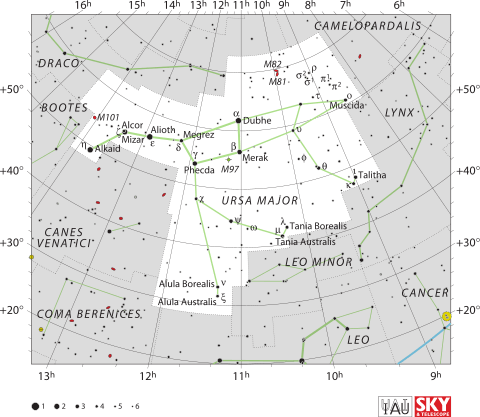Lambda Ursae Majoris
Lambda Ursae Majoris (λ Ursae Majoris, abbreviated Lambda UMa, λ UMa), formally named Tania Borealis /ˈteɪniə ˌbɒriˈælɪs/,[11][12] is a star in the northern circumpolar constellation of Ursa Major.
 Location of λ Ursae Majoris (circled) | |
| Observation data Epoch J2000 Equinox J2000 | |
|---|---|
| Constellation | Ursa Major |
| Right ascension | 10h 17m 05.78287s[1] |
| Declination | +42° 54′ 51.6808″[1] |
| Apparent magnitude (V) | +3.45[2] |
| Characteristics | |
| Spectral type | A2 IV[3] |
| U−B color index | +0.06[2] |
| B−V color index | +0.03[2] |
| Astrometry | |
| Radial velocity (Rv) | +18.1[4] km/s |
| Proper motion (μ) | RA: –180.65[1] mas/yr Dec.: –46.07[1] mas/yr |
| Parallax (π) | 23.72 ± 0.78[1] mas |
| Distance | 138 ± 5 ly (42 ± 1 pc) |
| Absolute magnitude (MV) | +0.10[5] |
| Details | |
| Mass | 2.11[6] M☉ |
| Radius | 2.3[7] R☉ |
| Luminosity | 37[7] L☉ |
| Surface gravity (log g) | 3.76±0.14[6] cgs |
| Temperature | 9,247±314[6] K |
| Metallicity [Fe/H] | +0.20[8] dex |
| Rotational velocity (v sin i) | 50[9] km/s |
| Age | 380[6] Myr |
| Other designations | |
| Database references | |
| SIMBAD | data |
Properties
This star has an apparent visual magnitude of +3.45,[2] making it one of the brighter members of the constellation. The distance to this star has been measured directly using the parallax technique, which yields a value of roughly 138 light-years (42 parsecs) with a 4% margin of error. The stellar classification of Lambda Ursae Majoris is A2 IV,[3] with the luminosity class of 'IV' indicating that, after 410 million years[13] on the main sequence, this star is in the process of evolving into a giant star as the supply of hydrogen at its core becomes exhausted. Compared to the Sun it has 240% of the mass and 230% of the Sun's radius, but is radiating 37 times as much luminosity.[7] This energy is being emitted from the star's outer atmosphere at an effective temperature of 9,280 K,[8] giving it the characteristic white-hot glow of an A-type star.[14]
Nomenclature
λ Ursae Majoris (Latinised to Lambda Ursae Majoris) is the star's Bayer designation.
It bore the traditional names Tania (shared with Mu Ursae Majoris) and Tania Borealis. Tania comes from the Arabic phrase Al Fiḳrah al Thānia 'the Second Spring (of the Gazelle)'.[15] and Borealis (originally borealis[16]) is Latin for 'the north side'. In 2016, the International Astronomical Union organized a Working Group on Star Names (WGSN)[17] to catalog and standardize proper names for stars. The WGSN's first bulletin of July 2016[18] included a table of the first two batches of names approved by the WGSN; which included Tania Borealis for this star.
In Chinese, 三台 (Sān Tái), meaning Three Steps, refers to an asterism consisting of Lambda Ursae Majoris, Iota Ursae Majoris, Kappa Ursae Majoris, Mu Ursae Majoris, Nu Ursae Majoris and Xi Ursae Majoris. Consequently, the Chinese name for Lambda Ursae Majoris itself is 中台一 (Zhōng Tái yī, English: Star of First Middle Step).[19]
References
- van Leeuwen, F. (November 2007), "Validation of the new Hipparcos reduction", Astronomy and Astrophysics, 474 (2): 653–664, arXiv:0708.1752, Bibcode:2007A&A...474..653V, doi:10.1051/0004-6361:20078357
- Johnson, H. L.; et al. (1966), "UBVRIJKL photometry of the bright stars", Communications of the Lunar and Planetary Laboratory, 4 (99), Bibcode:1966CoLPL...4...99J
- Cowley, A.; et al. (April 1969), "A study of the bright A stars. I. A catalogue of spectral classifications", Astronomical Journal, 74: 375–406, Bibcode:1969AJ.....74..375C, doi:10.1086/110819
- Evans, D. S. (June 20–24, 1966), "The Revision of the General Catalogue of Radial Velocities", in Batten, Alan Henry; Heard, John Frederick (eds.), Determination of Radial Velocities and their Applications, Proceedings from IAU Symposium no. 30, University of Toronto: International Astronomical Union, Bibcode:1967IAUS...30...57E
- Eggen, Olin J. (July 1998), "The Age Range of Hyades Stars", The Astronomical Journal, 116 (1): 284–292, Bibcode:1998AJ....116..284E, doi:10.1086/300413.
- David, Trevor J.; Hillenbrand, Lynne A. (2015), "The Ages of Early-Type Stars: Strömgren Photometric Methods Calibrated, Validated, Tested, and Applied to Hosts and Prospective Hosts of Directly Imaged Exoplanets", The Astrophysical Journal, 804 (2): 146, arXiv:1501.03154, Bibcode:2015ApJ...804..146D, doi:10.1088/0004-637X/804/2/146.
- Malagnini, M. L.; Morossi, C. (November 1990), "Accurate absolute luminosities, effective temperatures, radii, masses and surface gravities for a selected sample of field stars", Astronomy and Astrophysics Supplement Series, 85 (3): 1015–1019, Bibcode:1990A&AS...85.1015M
- Hill, G. M. (February 1995), "Compositional differences among the A-type stars. 2: Spectrum synthesis up to V sin i = 110 km/s", Astronomy and Astrophysics, 294 (2): 536–546, Bibcode:1995A&A...294..536H
- Royer, F.; Zorec, J.; Gómez, A. E. (February 2007), "Rotational velocities of A-type stars. III. Velocity distributions", Astronomy and Astrophysics, 463 (2): 671–682, arXiv:astro-ph/0610785, Bibcode:2007A&A...463..671R, doi:10.1051/0004-6361:20065224
- "lam UMa -- High proper-motion Star", SIMBAD, Centre de Données astronomiques de Strasbourg, retrieved 2012-01-20
- Kunitzsch, Paul; Smart, Tim (2006). A Dictionary of Modern star Names: A Short Guide to 254 Star Names and Their Derivations (2nd rev. ed.). Cambridge, Massachusetts: Sky Pub. ISBN 978-1-931559-44-7.
- "IAU Catalog of Star Names". Retrieved 28 July 2016.
- Su, K. Y. L.; et al. (December 2006), "Debris Disk Evolution around A Stars", The Astrophysical Journal, 653 (1): 675–689, arXiv:astro-ph/0608563, Bibcode:2006ApJ...653..675S, doi:10.1086/508649
- "The Colour of Stars", Australia Telescope, Outreach and Education, Commonwealth Scientific and Industrial Research Organisation, December 21, 2004, archived from the original on March 10, 2012, retrieved 2012-01-16
- Richard Hinckley Allen :Star Names — Their Lore and Meaning - Ursa Major, the Greater Bear
- Piazzi, G., The Palermo Catalogue, Palermo, 1814.
- "IAU Working Group on Star Names (WGSN)". Retrieved 22 May 2016.
- "Bulletin of the IAU Working Group on Star Names, No. 1" (PDF). Retrieved 28 July 2016.
- (in Chinese) (Activities of Exhibition and Education in Astronomy) 天文教育資訊網 2006 年 6 月 21 日